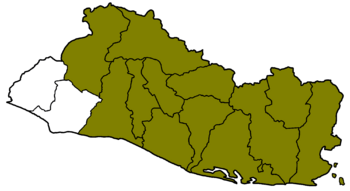Intendancy of San Salvador facts for kids
Quick facts for kids
Intendancy of San Salvador
Intendencia de San Salvador
|
|||||||||
|---|---|---|---|---|---|---|---|---|---|
| 1785–1821 | |||||||||

Territory controlled by the intendancy is shaded.
|
|||||||||
| Status | Spanish colony | ||||||||
| Capital | San Salvador | ||||||||
| Common languages | Spanish | ||||||||
| Religion | Roman Catholicism | ||||||||
| Government | Intendancy | ||||||||
| King | |||||||||
|
• 1785–1788
|
Charles III | ||||||||
|
• 1788–1808
|
Charles IV | ||||||||
|
•
|
Ferdinand VII | ||||||||
| Colonial Intendant | |||||||||
|
• 1786–1789
|
José Ortiz de la Peña (first) | ||||||||
|
• 1819–1821
|
Pedro Barriere (last) | ||||||||
| Historical era | Bourbon Reforms | ||||||||
|
• Established
|
1785 | ||||||||
|
• Independence of
Central America |
15 September 1821 | ||||||||
|
• Disestablished
|
21 September 1821 | ||||||||
| Population | |||||||||
|
• 117,436
|
1778 | ||||||||
|
• 145,906
|
1800 | ||||||||
|
|||||||||
| Today part of | El Salvador | ||||||||
The Intendancy of San Salvador (Spanish: Intendencia de San Salvador) was a special way the Spanish Empire governed a part of Central America. It was like a large district within the Captaincy General of Guatemala. This Captaincy General was itself a big part of the Viceroyalty of New Spain, which was a huge Spanish colony.
This special district, called an intendancy, was created in 1785. It was part of big changes called the Bourbon Reforms. These reforms aimed to give Spain more control over its colonies. The Intendancy of San Salvador was one of several new intendancies formed at that time.
The intendancy ended in 1821. This happened after the Act of Independence of Central America was signed on September 15, 1821. This act declared that Central America was free from Spain. San Salvador then became a province within the new United Provinces of Central America.
Contents
How the Intendancy Was Formed
Before 1785, the area that is now El Salvador was known as the Greater Mayorship of San Salvador. This was an older way of governing left over from earlier Spanish rule.
In the late 1700s, the Spanish king wanted to make his empire stronger. He started the Bourbon Reforms. These reforms aimed to centralize power and take some control away from local wealthy families. However, these changes often led to resistance from people born in the colonies, known as Creoles.
As part of these reforms, the Intendancy of San Salvador was created. Other similar intendancies were also formed, like those in Ciudad Real, Comayagua, and León. These new districts took away a lot of power from the main government in Guatemala.
Who Governed the Intendancy?
- Further information: Colonial Intendant of San Salvador
When the old mayorship became an intendancy in 1785, the mayor, Manuel Fradique y Goyena, stayed in charge for a short time. In 1786, he was replaced by José Ortiz de la Peña. He became the first official leader, called a colonial intendant.
After him, Francisco Luis Héctor de Carondelet took over in 1789. During his time, the production of indigo, a valuable dye, went down. This was because there were fewer local indigenous people to do the work. Carondelet brought in Spanish workers to help. This led to more people with lighter skin in northern El Salvador today, especially in the Chalatenango Department. These people are descendants of those Spanish workers. Carondelet was seen as a very good intendant for San Salvador.
In 1791, Carondelet moved on to govern Louisiana. Many other intendants followed him, some serving for only a few years.
How San Salvador Gained Independence
- Further information: 1811 Independence Movement and Act of Independence of Central America
On November 5, 1811, people in San Salvador started an uprising. This event is known as the 1811 Independence Movement. They removed the current intendant, Antonio Gutiérrez y Ulloa. José Mariano Batres y Asturias took his place temporarily.
Later, Colonel José Alejandro de Aycinena became intendant in December 1811. He worked to stop the independence movement. He resigned in 1812, and José María Peinado y Pezonarte took over. Peinado y Pezonarte governed until 1814, during another independence movement.
The last intendant was Pedro Barriere. On September 15, 1821, important leaders like José Cecilio del Valle and José Matías Delgado met in Guatemala City. They signed the Act of Independence of Central America. This act declared that the Central American provinces, including San Salvador, were free from Spain.
On September 21, 1821, the Intendancy of San Salvador accepted this declaration. It was then dissolved and became the Province of San Salvador. This new province was part of the United Provinces of Central America. Pedro Barriere became its first political chief.
Economy of the Intendancy
In 1782, the Spanish king made trade easier between Spain and its colonies. He lowered taxes and fees on goods. This change greatly increased the amount of goods being traded. As a result, the economy and population of San Salvador and other colonies grew a lot.
During Spanish rule, indigo was the most important product exported from San Salvador. Indigo is a plant used to make a blue dye. It was so important that it controlled much of the economy. The city of Guatemala also lost a lot of its power and wealth when San Salvador became an intendancy. This was partly because Guatemala lost control over San Salvador's valuable indigo exports.
See also
 In Spanish: Intendencia de San Salvador para niños
In Spanish: Intendencia de San Salvador para niños




